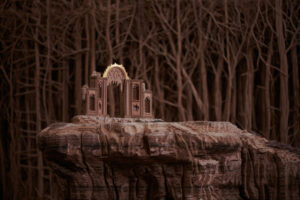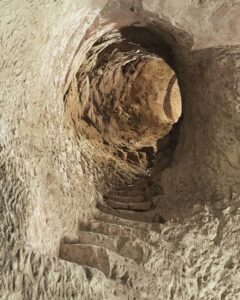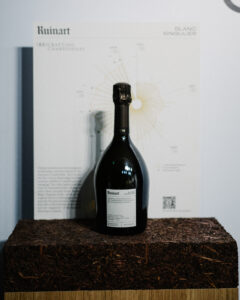It seemed almost impossible how the narrow stairs could transport people to a seemingly endless journey that took one to and from over 100 feet below ground. And that mystical feeling was enhanced by the walls and ceiling as they had undulating designs that created a cathedral-like aura with a sacred electric energy pulsating through the air. One simultaneously felt sucked into this otherworld and transported to a place 3,700 miles away.
An art piece located in New York City’s Manhattan that French artist Eva Jospin created was transporting New Yorkers as her piece perfectly emulated a miniature version of the magnificent caves dug below Champagne houses, in the wine region of Champagne, France; caves that were carved deep below the chalk soil. In this instance, it gave the impression of one of the caves of the oldest Champagne house, Maison Ruinart, which was initially excavated well over a millennium ago by the Romans for chalk mines yet resourceful Champagne producers, such as Nicolas Ruinart, used these caves to store their Champagne bottles for aging, starting in the mid-1700s.
Yet this work of art was made from cardboard! Astonishing considering how it enchanted those who gazed upon it and temporarily made the viewer forget that it was in a bustling city instead of the magical world of the “Crayères” (a.k.a. vertical chalk pits) as they are known in the Champagne sparkling wine region.
Also, this pop-up NYC art gallery brought thrilling news as Ruinart plans to release its first new Champagne cuvée in 20 years.
Maison 1729

Photo Credit: @FLAVIEN PRIOREAU
Such art pieces showcased at the High Line in NYC illustrated Ruinart’s commitment to art and sustainability and how both can form a symbiotic relationship. As Ruinart has had a mission over recent years of finding innovative ways to promote biodiversity, such as planting 25,000 trees and shrubs within their vineyards and even commissioning land art pioneer Nils-Udo to build three tall birds’ nests to bring many feathered creatures to come to the Ruinart Taissy vineyard. And considering how creative Ruinart has been with encouraging biodiversity, it makes sense that they would partner up with the High Line as it is also an entity that has pushed boundaries in regards to how global cities can create more biodiversity by saving a historic, elevated freight rail line from being demolished by turning it into a public park with various species of plants.
This partnership is called Maison 1729: From the Vineyards of Champagne to the High Line, as it represents the initial establishment of Maison Ruinart in 1729 to today’s exciting relationship with a relatively new initiative, the High Line, which has become one of the most visited sites in all of New York City.
Ruinart Blanc Singulier
But Ruinart is not only making changes in the vineyards, as previously mentioned, it is also releasing its first new Champagne cuvée in 20 years called Blanc Singulier. As climate change has brought warmer vintages among the cooler vintages, Ruinart has decided to make a 100% Chardonnay cuvée that has low-to-no dosage that is made during the warmest vintages from the Chardonnay vineyards that get the most ripeness.
The first is called Blanc Singulier ‘Edition 18’ as it is made from 80% of the 2018 vintage and the rest is made from older reserve wines that all come from warmer vintages with a 0 g/l dosage, making it a Brut Nature Champagne with no sugar added during dosage. Brut Nature Champagnes have become very trendy in some circles and many Brut Nature Champagnes have come onto the market, with some being great examples and others being off-balanced as they lack the ripeness to balance the extreme acidity on their own, and so, some needed that small amount of sugar to help create a balanced wine; there is a reason why most Champagnes need a little bit of sugar.
Creatively Resourceful
Ruinart President & CEO Frederic DuFour spoke about never releasing a new cuvée to satisfy a trend, as Ruinart’s reputation is based on excellence by adhering to values established almost 300 years ago. One of those values is always to be faithful to the terroir, the sense of place of the vineyards and over time, they noticed that part of the terroir in some recent years gives a bit of a richer expression that does not require added sugar to help take the edge off the acidity to allow the fruit to shine.
The Champagne wine region has had a long history of being creatively resourceful, beginning with using the deep chalk pits as the ideal places to age Champagne bottles gracefully and using sugar to balance the high acidity. Today, the oldest Champagne house, which has been an essential part of this resourcefulness from the beginning, is now finding the benefit within the difficult times of climate change by releasing Blanc Singulier, a Champagne that expresses the terroir in modern times that lives up to values that are several centuries old.
******Clink here to read original article published on Forbes.













